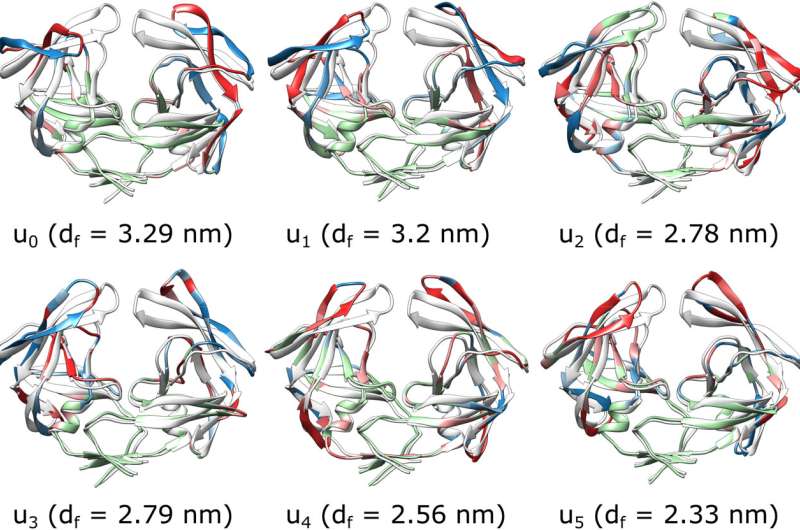This article has been reviewed according to Science X's editorial process and policies. Editors have highlighted the following attributes while ensuring the content's credibility:
fact-checked
peer-reviewed publication
trusted source
proofread
Scientists use supercomputer to detail HIV protein mechanism crucial for drug development

Every disease has a protein basis.
For some diseases, like HIV, changes in protein structure are critical for how the virus infects a person's cells.
Researchers at the University of Illinois Chicago (UIC) have used the Theta supercomputer at the U.S. Department of Energy's (DOE) Argonne National Laboratory to find the essential factors that control a certain structural change of HIV protease, a key viral protein. The structural change is called a flap opening, and it occurs when the virus is binding to another molecule, like an antiviral drug. Understanding this structure change is critical for drug development.
The Theta supercomputer is housed at the Argonne Leadership Computing Facility (ALCF), a DOE Office of Science user facility at Argonne that is open to the world's scientific community.
"Proteins are what make life work; proteins hold the answer to most biological questions," said Ao Ma, associate professor of Biomedical Engineering at UIC. "When we look at proteins, we see structure determines function. But proteins don't just have one structure, they have multiple functional structures, and the transitions between those structures determine how proteins work."
In the research, Ma and his students performed molecular dynamics simulations on Theta to collect data that they then analyzed using a mathematical method. "The neat thing about the method we used is that it all derives from Newton's second law—that force equals mass times acceleration," Ma said.
Proteins are constantly in motion, but Ma wanted to know which particular factors within the protein were ultimately in charge of its structural change. "Proteins are large molecules with thousands to hundreds of thousands of atoms, and they're constantly moving—so it's important to simplify this problem to see which particular components of the motion dictate the overall structural evolution."
According to Ma, scientists use coordinates to describe how a protein moves.
Coordinates are values that help us describe the position or location of an object within a specific space. Think of them like an address for a point in space. In a 3D space, like the world around us, we use three coordinates (x, y and z) to describe a point's location, with x representing the horizontal position, y representing the vertical position, and z representing the depth. Coordinates allow us to understand and describe the arrangement and movement of objects in a given space.
It is also possible to describe coordinates in relationship to each other, which are called internal coordinates. Internal coordinates focus on the distances between the atoms, the angles formed by the bonds connecting them and the rotation of groups of atoms around these bonds. These internal coordinates form the basis of the reaction coordinates that Ma and his students studied.
"There are many thousands of coordinates involved in how HIV protease moves, but we were able to identify the six reaction coordinates that together completely determine how its structure changes," Ma said.
The reaction coordinates that Ma identified are combinations of what scientists call dihedral angles. A dihedral angle is an internal angle between two planes formed by four atoms connected in a zigzag pattern by three bonds.
"Imagine you have a line of four atoms connected by three bonds, like beads on a string. Now, picture the first three atoms forming a triangle, creating a plane. Then, imagine the last three atoms forming another triangle, creating a second plane," Ma said. "The dihedral angle is the angle between these two planes, and it helps describe the rotation or twisting of the molecule around the central bond connecting the two planes."
Finding the specific way to combine the dihedral angles to give reaction coordinates gives scientists a clear picture of how the flap opening occurs. "This is a major step forward for correctly understanding the molecular mechanisms behind this virus and hopefully will yield new strategies and targets for drug discovery," Ma said.
A paper based on the study, "Exact reaction coordinates for flap opening in HIV-1 protease," was published online on Dec. 2, 2022 in the Proceedings of the National Academy of Sciences.
More information: Shanshan Wu et al, Exact reaction coordinates for flap opening in HIV-1 protease, Proceedings of the National Academy of Sciences (2022). DOI: 10.1073/pnas.2214906119
Journal information: Proceedings of the National Academy of Sciences
Provided by Argonne National Laboratory





















